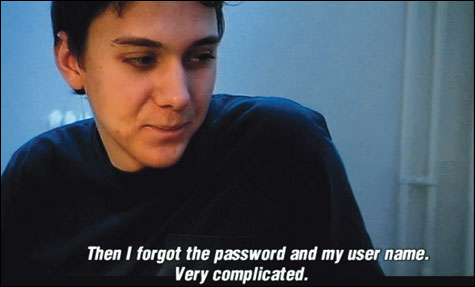
LET’S GET PHYSICAL/DIGITAL: When Christian Jankowski fails, it isn’t for lack of wit or commitment.
|
“Sensorium I,” which was up at MIT’s List Center between October and December last year, was an ambitious mixed bag of what one critic aptly termed “circus art.” Mega installations that included tall walls that gave up foul-smelling odors when touched. Long corridors whose lights and sounds could induce a seizure. Various big rooms, some actual and some on video, where events occurred that were either mysterious or banal, depending on your taste and patience.
Now we have “Sensorium II.” Gone are the elephants and big cats and human cannonballs; we’re down to the jugglers and clowns, and not many at that. The one carry-over from “Sensorium I” is Mathieu Brand’s Ubiq, a Mental Odyssey, in which you don ingeniously engineered headgear and find your perspective switching between seeing what you’re looking at and what someone else wearing the same headgear is looking at. It was delightful the first time I tried it; I hadn’t realized how much of a one-liner it would turn out to be until last week, when I was in the company of the MassArt graduate students I teach who’d all seen “Sensorium I.” Of the 25 of us who’d partaken of the mental odyssey last time around, only one was inclined to repeat the experience.
Christian Jankowski is a funny, iconoclastic, smart video artist, so even when he misses the mark, as he does in Let’s Get Physical/Digital, it isn’t for want of wit or commitment. Jankowski inserts himself into videos that are themselves real-world events — a TV psychic hotline in which he’s the caller; an evangelical prayer service during which he lies passed out on the altar; a television talk show on the subject of performance art that sees him silently circle the set while the guests discuss his antics. He’s at his best when he’s unrehearsed, when the dialogue is unscripted: the richness of his playful intrusions depends on the complete seriousness of the other performers. Let’s Get Physical/Digital takes Web chat-room conversations between Jankowski and his girlfriend — from a period when they were living in different countries and couldn’t afford to phone — that are mouthed by varying pairs of amateur actors in drab sets with bad lighting. Even though we don’t know the exact origins of the dialogue, it’s clear that the words being spoken issue from cyberspace, with the result that the physical nearness of the actors is weirdly at odds with their echo-like protestations of love. But the hollowness Jankowski is after — language emptied of meaning, proximity stripped of closeness — is undermined by the artist’s self-consciousness. He knew all along he’d be saving the transcripts of the conversations for a performance piece, so the male half of the now spoken dialogue sounds stilted and insincere. There’s also no reason, except for the List Center’s need to occupy its cavernous space, for the video projection to measure in at something like 30 by 30 feet; what’s interesting about Let’s Get Physical/Digital isn’t about the gigantic, it’s about the small.
Here’s the first line of the wall text that accompanies Anri Sala’s video Natural Mystic: “An insistent slippage between sight and sound, forging a poetic alliance of absence and presence, plays a vital role in Albanian artist Anri Sala’s early docudramas and prefigures the synaesthetic facet of his recent work.” You may not have figured out that that means Sala whistles and makes puffing sounds into a microphone in a room with a set of drums. But to witness the emperor’s new clothes in all their finery, check out Sala’s Now I See in which a writhing teen rock band, seen from the waist down, share the screen with a balloon twisted into the shape of a long-eared dog.
The two other components of “Sensorium II” are so unobtrusive as almost not to be there — in fact, one isn’t. Feeling bold, I announced to the attendant that I wanted to participate in Mi(pi) Bar, the contribution from François Roche, Stephanie Lavaux, and Jean Navarro. One of five elaborate ceiling-to-floor panels says that “individual containers will be accessible at the List Visual Art Center” for the purification of one’s urine, which I would then be invited to drink. All in a day’s work. I was informed, however, that the project was never actually executed (the cost proved prohibitive) and that the exhibit was “just a thought.” Returning to the wall text, I realized my mistake. R&Sie(n) — that’s the cool acronym they go by — “proposed a project about sustainability that is also designed to provoke a phobic response.” That is, a real response to a fake situation. This could have major repercussions in places like MassArt if students start passing off proposals as projects, but that’s for others to worry about.